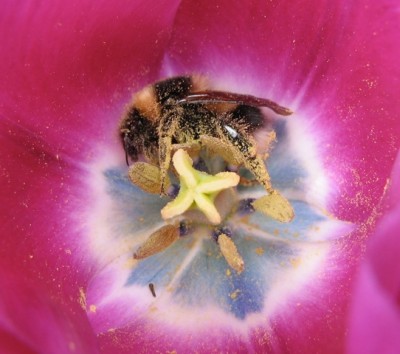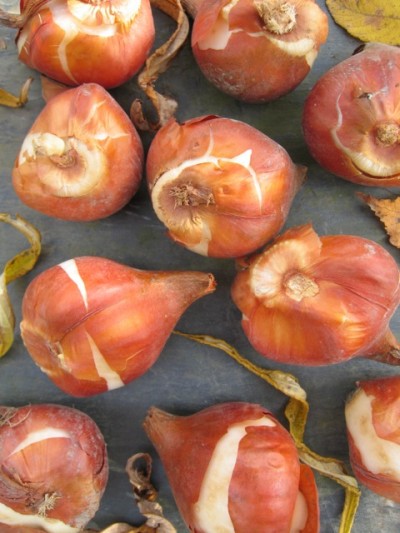Bulbs are packed with promise, heralding the return of the light. Choose organic bulbs and earth-friendly growing methods, and that sense of hope can embrace the natural world.
After being shoved, protesting, into winter by the turning back of the clocks, we gardeners need an antidote to our enforced cutback on daytime pottering. We need something filled with hope, with endless possibility and promise, to pull us through. We need a lifeline to cast out in the direction of spring, to tug us gently on until day begins once more to outdo night and we can force the clocks’ hands forward again. Foliage, flowers, scent and luminous bark can help light our journey, but there’s one group of plants which keeps us in its spell, watching and waiting, for months on end: bulbs.
Planting bulbs, be they spring- or summer-flowering, is an act of faith. We bury these demure, rustling nuggets of hope, in soil or compost, trusting them to do their stuff many months on. Whenever I plant bulbs, I have a keen sense that what’s passing through my hands is as close to magic as gardening ever gets; it seems an impossibility that these pre-destined, all-in-one bundles can conjure such riots of colour and delight. Of all gardening’s magical moments – seeds coming up, unearthing new potatoes, cutting the first sweet peas – watching bulbs push their coy, pale leaf tips into the light before going full pelt into bloom is surely the best.

If I had to choose my favourite spring bulb, the best I can muster is a tie between snowdrops and tulips. Snowdrops flood the wild fringes of my garden, and I add to them constantly. Once they’re in, they’re in, and they do their own thing; their biggest call on me is clearing them of dead fern fronds, so they don’t get lanky. Tulips are restricted to pots; they would never survive the foraging by furry creatures great and small that goes on here. I plant them in one of my home-made ‘magic’ ingredients, a potting mix made from leaf mould and worm-worked compost (half and half), in pre-loved 30cm (12in) diameter clay pots, eight to 10 bulbs in each. A sheet of fine chicken mesh is laid over the pots, weighted down, to keep out shrews, mice, voles and squirrels. When the Welsh rain is in a drowning mood, secondary glazing units offer respite.
I love this coming together of the home-made, the reused, the pre- and then re-loved, the compostable, the recycled, the repurposed and the endlessly renewable (think leaf mould and garden compost). Making use of what’s already been made in the world, and tapping into nature’s bounty, is about as earth-friendly as gardening gets; it’s a magic moment in itself. Add to this choosing seeds, plants and bulbs which have been grown in a nature-friendly, organic way, using peat-free compost, and gardening without synthetic pesticides, or vast amounts of energy, and the enchantment is complete. The only spell-breaker here is that while the range of organically grown (and certified) seeds and plants is varied and slowly growing, getting hold of organic flower bulbs is harder than pulling slugs’ teeth.
Back in July I ordered an ‘ecobulb’ tulip collection from The Organic Gardening Catalogue. These bulbs are grown in the Netherlands by www.ecobulbs.nl on land reclaimed from the sea, and converted to biodynamic cultivation. Since 1993, tulips (as well as daffodils, ornamental onions and other spring bulbs) have been grown in a seven-year rotation with arable crops (which helps reduce soil diseases by ‘resting’ it between different crops). None of the bulbs are treated with any insecticides (such as polluting neonicotinoids or ‘neonics’), fungicides or weedkillers, or fed with synthetic fertilisers. The plants are grown at much lower densities than those found in typical ‘factory farmed’ bulb fields, and are harvested only when the mature bulbs reach the optimum stage in their yearly growth cycle.
Lower density growing and more manual labour, for jobs such as weeding, hints that the bulbs ought to be more expensive, but my collection of 10 bulbs each of eight varieties works out at around 50p per bulb (excluding delivery), which for some varieties is comparable with mass-produced versions. Anyway, I’m happy to pay more to support real green horticulture that respects our natural world. All 80 bulbs about to be potted up are top quality and arrived in immaculately labelled (and compostable) paper pouches, in a cardboard box (that’ll send my tiger worms into a frenzy, too).

Growing tulips and other flower bulbs intensively requires regular, high inputs of fertilisers, pesticides and weedkillers, plus the energy to power the equipment used to plant, spray, harvest and grade the resulting bulbs. The huge blocks of contrasting colour seen in classic images of Dutch bulb-growing regions are some of the most intensively farmed (and polluted) areas on earth (this video, which features an aptly named ‘Earth Eater’, gives a feel for the scale of the non-organic bulb industry).
Systemic insecticides (including neonics and other products used on bulbs) infiltrate a plant from root tip to shoot tip, passing their toxic load into the plant’s sap, pollen and nectar. If this is foraged by bees and other insects, they unwittingly receive a dose of the pesticide, or carry it back to their nests. As insect populations falter, bug-eating birds find it harder to find enough food, so their populations also decline. Neonics also make their way into aquatic ecosystems, and into the soil, where they can accumulate and persist for years.
It was, ironically, Dutch researchers who recently published a study on the effects on birds of the neonic imidacloprid (once used widely in UK gardens). When these chemicals are used on bulbs, they sink deep into their hearts, and remain there until we grow them; a factory-farmed bulb might only unlock its poisoner’s potential when it blooms in our gardens. Although three neonics, including imidacloprid, are currently banned in Europe, others are still in use. The tulip bulbs I’m itching to plant look just like those I can buy at a garden centre. I know what’s gone into the making of mine, but I’ve little idea about any others.
I can have faith in my tulips to not only pull me through the darkening ahead, but to bring me only riotous delight, and offer insects pollen and nectar untainted by toxins. Now that’s what I call magic.
Text and images © John Walker


